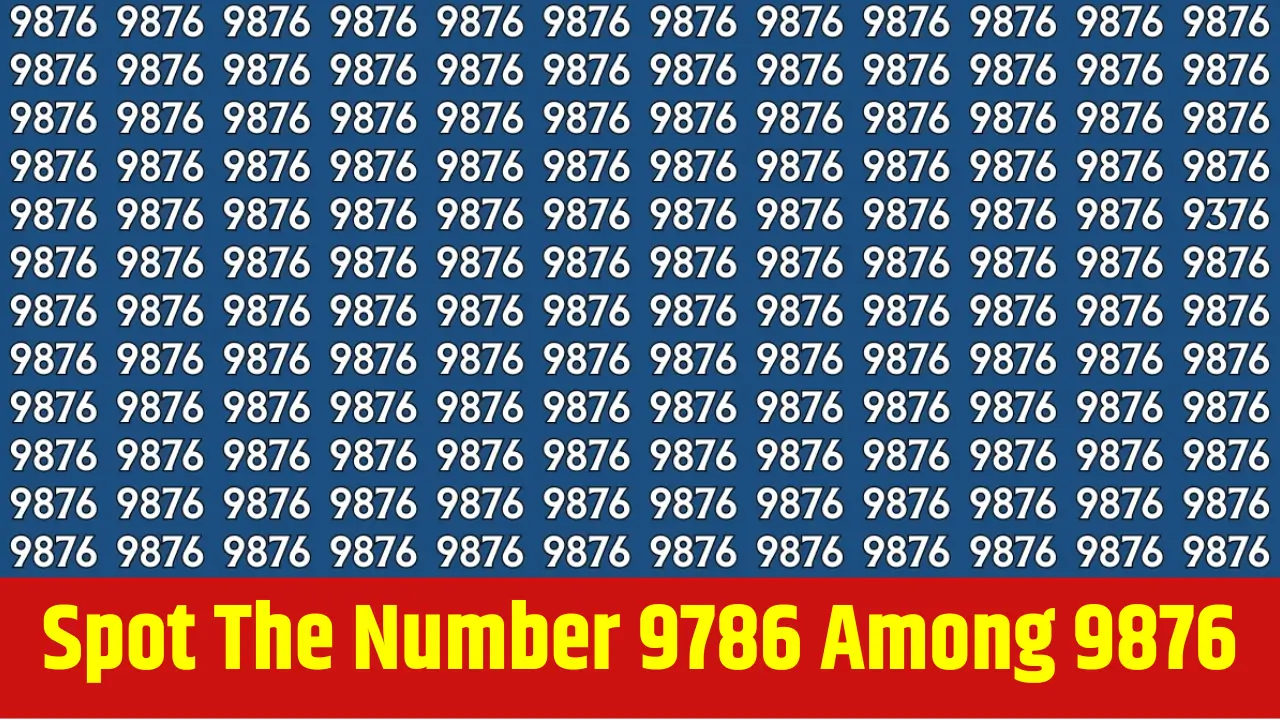Optical illusions are intriguing puzzles that push the limits of our perception and attention to detail.
One of the latest challenges making waves across puzzle communities is the Optical Illusion: Spot the Number 9786 Among 9876. At first glance, the two number sequences seem almost identical, but hidden within the mass of “9876” digits lies one distinct “9786”.
Though the difference is minor, only sharp-eyed observers can detect it quickly without being misled by the brain’s tendency to overlook fine visual changes.
In this article, we take a close look at how such number-based illusions function, why spotting 9786 among 9876 proves so tricky, strategies to solve them, and the cognitive benefits of testing observation through puzzles.
We will also explore the psychology of pattern recognition and highlight how everyday skills are improved by participating in such challenges.
What Is the Optical Illusion Puzzle 9786 vs 9876?
This puzzle presents a visual challenge where the grid is filled with the repeating sequence 9876. Within that repetition, the anomaly 9786 is hidden. The player must carefully analyse the sequence to detect the different number.
The distinguishing difference lies in a digit swap. While 9876 contains “8” as the second figure, the hidden number 9786 places a “7” there instead, switching the positions of 7 and 8. Despite being a small change, it creates a demanding puzzle because of visual similarity and repetition across the entire grid.
Why Spotting 9786 Among 9876 Is Difficult
Human perception makes such puzzles deceptively complex. When looking at endless repetitions of 9876, the brain enters a form of pattern recognition mode, meaning it assumes all entries are identical without actually processing each digit carefully.
Several psychological and cognitive factors contribute:
- Repetition blindness: Repeated sequences numb the brain into overlooking small inconsistencies.
- Digit similarity: The figures 7 and 8 share similar visual structures, confusing the eye under quick scanning.
- Cognitive shortcuts: The brain prefers speed, quickly concluding that every sequence is the same rather than analysing thoroughly.
- Stress of time: Many attempts are timed, putting pressure on the solver and decreasing accuracy.
The Psychology of Number-Based Illusions
Number spotting challenges like this one are rooted in the brain’s handling of visual information. The visual cortex processes digits as shapes, while the prefrontal cortex works to compare details. Optical illusion puzzles deliberately exploit the brain’s bias for speed and predictability.
By forcing us to slow down and pay attention to detail, they highlight how perception can be misleading but also how careful observation can overcome assumptions.
Key Difference Between 9786 and 9876
To understand the challenge more clearly, here’s a breakdown in table form:
| Number | First Digit | Second Digit | Third Digit | Fourth Digit | Notable Variation |
| 9876 | 9 | 8 | 7 | 6 | Repeated base sequence |
| 9786 | 9 | 7 | 8 | 6 | Digits ‘7’ and ‘8’ swapped positions |
This tiny swap between the second and third digits makes the puzzle demanding. The brain tends to view both sequences as interchangeable due to their high similarity.
Strategy to Solve the Puzzle
While some people might rely purely on luck or random scanning, applying structured observation techniques improves the odds of detecting the anomaly quickly.
- Target the second digit: Since the anomaly replaces “8” with “7”, search column by column for sequences beginning with “97”.
- Segment the puzzle: Break the grid into smaller sections and check each one thoroughly rather than scanning all at once.
- Avoid rushing: Calm, steady focus usually succeeds better than racing under pressure.
- Reset focus periodically: Looking away for a second and returning can refresh your recognition.
- Confirm sequentially: Once “97” is found at the beginning of a number, confirm the next digits “86” for accuracy.
Benefits of Number-Based Optical Illusions
These puzzles go beyond entertainment by sharpening cognitive and observational abilities.
Mental and Cognitive Benefits
- Trains the brain to spot details quickly and accurately.
- Improves short-term memory by requiring digit retention.
- Encourages patience and systematic problem-solving.
- Heightens focus and attention span.
Practical Benefits
- Helps professionals such as auditors, designers, editors, and proofreaders refine accuracy.
- Useful in education by improving children’s pattern recognition.
- Provides stress relief through engaging mental exercise.
Why These Challenges Are So Popular
The Optical Illusion: Spot the Number 9786 Among 9876 challenge has become popular worldwide, especially online, because of its simplicity and shareability. People are naturally curious to test how quickly they can detect the anomaly, and competitive solving adds to the engagement.
Unlike complex puzzles, these are inclusive, requiring no special skill set. Both adults and children can attempt them, making them widely appealing.
Real-Life Significance of Spot the Number Tests
Spot the Difference and Spot the Number puzzles are often used in professional and educational environments:
- Recruitment assessments: Certain companies employ pattern-spotting tests to evaluate focus.
- Education: Teachers use number puzzles to strengthen student attention spans and observational skills.
- Psychological training: Therapists employ such activities for patients with attention-related issues.
- Day-to-day accuracy: Detecting fine mistakes in contracts, coding, financial statements, or designs often resembles spotting anomalies in repeated sequences.
How Long Does It Take to Spot 9786?
- Average solver: Generally between 12–25 seconds.
- Fast observers: Under 8 seconds with careful strategy.
- Beginners: May take longer than 30 seconds, especially under time pressure.
Practice significantly improves completion rates as the eyes get trained to identify anomalies faster.
Long-Term Training With Optical Illusions
Consistent practice with such number puzzles can train the mind to avoid carelessness and improve accuracy. Some effective long-term benefits include:
- Detecting small differences in crowded data.
- Developing analytical patience.
- Reducing errors at work or in studies.
- Enhancing visual memory and rapid recognition in everyday life.
Conclusion
The Optical Illusion: Spot the Number 9786 Among 9876 puzzle perfectly illustrates how perception can mislead us when dealing with repetitive patterns.
By forcing us to focus on subtle differences, it sharpens observation, teaches patience, and highlights the importance of slowing down when accuracy is required.
More than a light-hearted challenge, it is also a valuable brain-training tool with real-world applications. Whether you solve it for relaxation, competition, or personal development, finding 9786 among dozens of 9876s is a reminder that details matter the most when the bigger picture seems uniform.
FAQs
1. What makes 9786 so hard to spot among 9876?
Because only the middle digits are swapped, the sequences appear almost identical to the casual eye, tricking the brain into thinking they are the same.
2. How long does it take to find the hidden number?
On average, solvers take between 12 and 25 seconds, though trained observers may succeed in under 8 seconds.
3. Are these number puzzles useful for children?
Yes, they improve focus, patience, and number recognition skills, making them effective learning tools.
4. Can optical illusion puzzles improve professional skills?
Yes, they sharpen attention to detail, benefiting professions like auditing, editing, programming, design, and data analysis.
5. Why do such puzzles become viral online?
Because they are simple to try, appealing to all age groups, and create competitive excitement as people compare solving times.












